医学论文英文摘要的写法
- 格式:pdf
- 大小:235.18 KB
- 文档页数:3
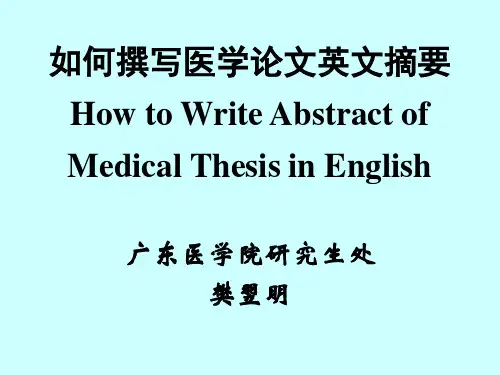


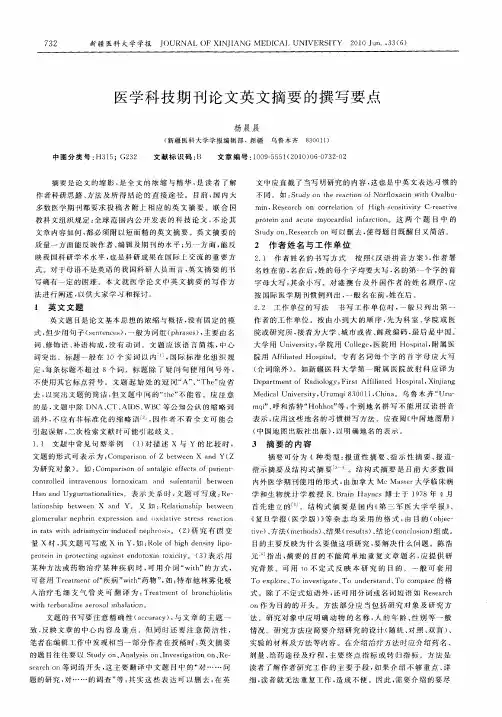
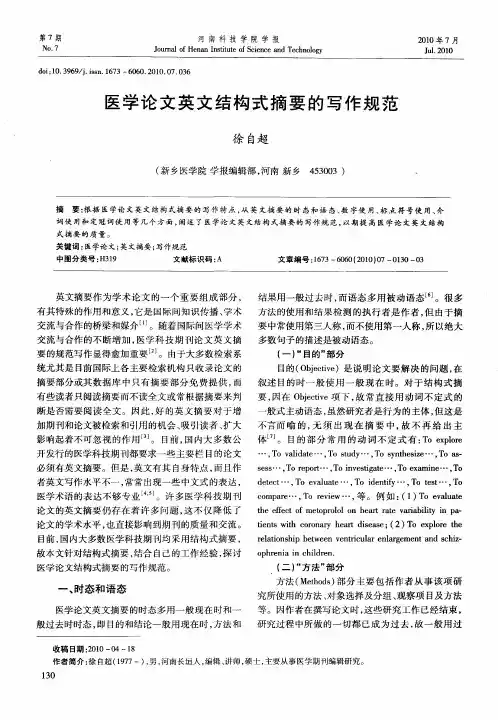
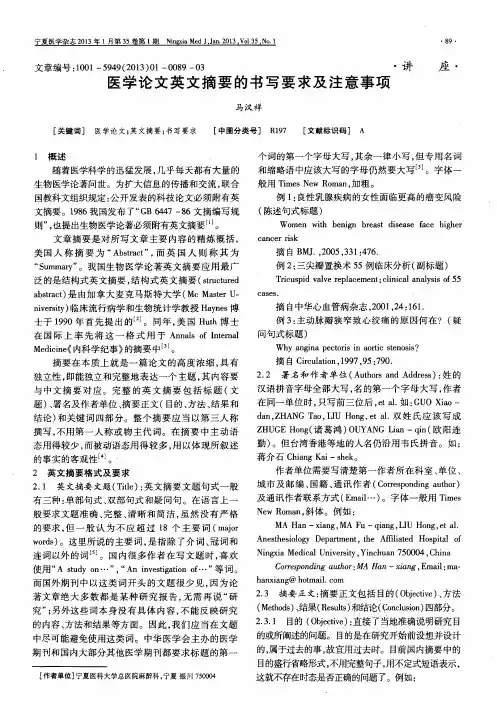
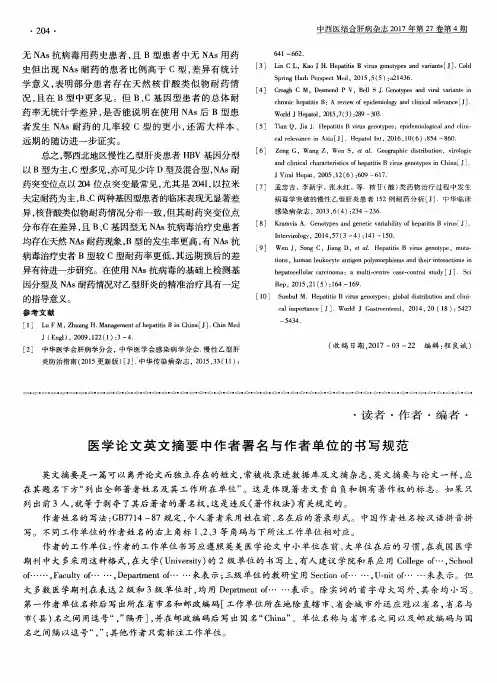
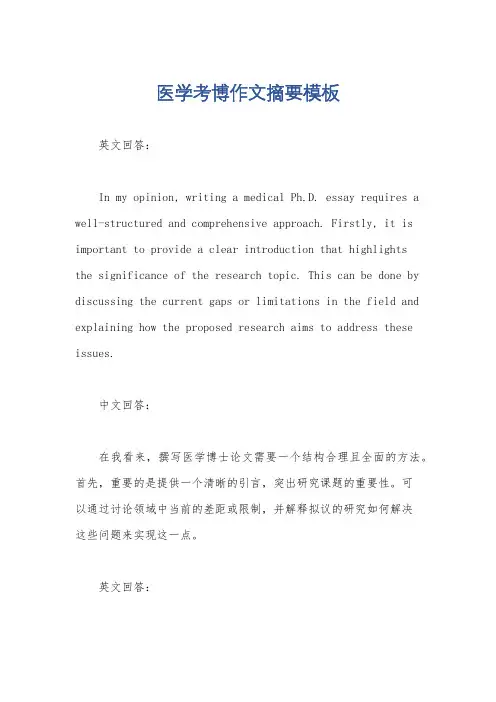
医学考博作文摘要模板英文回答:In my opinion, writing a medical Ph.D. essay requires a well-structured and comprehensive approach. Firstly, it is important to provide a clear introduction that highlights the significance of the research topic. This can be done by discussing the current gaps or limitations in the field and explaining how the proposed research aims to address these issues.中文回答:在我看来,撰写医学博士论文需要一个结构合理且全面的方法。
首先,重要的是提供一个清晰的引言,突出研究课题的重要性。
可以通过讨论领域中当前的差距或限制,并解释拟议的研究如何解决这些问题来实现这一点。
英文回答:The next step is to present a thorough literature review that demonstrates a deep understanding of the existing research and knowledge in the field. This can be achieved by critically analyzing and synthesizing relevant studies, identifying gaps in the literature, and explaining how the proposed research will contribute to filling these gaps.中文回答:下一步是提供一个全面的文献综述,展示对领域中现有研究和知识的深入理解。
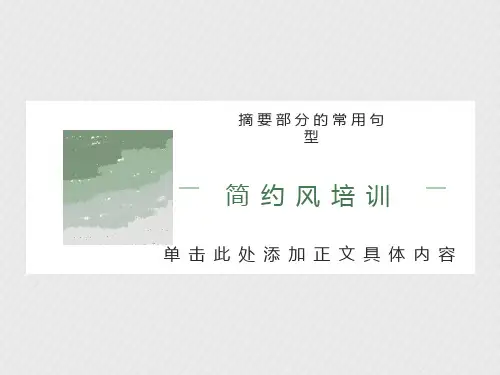
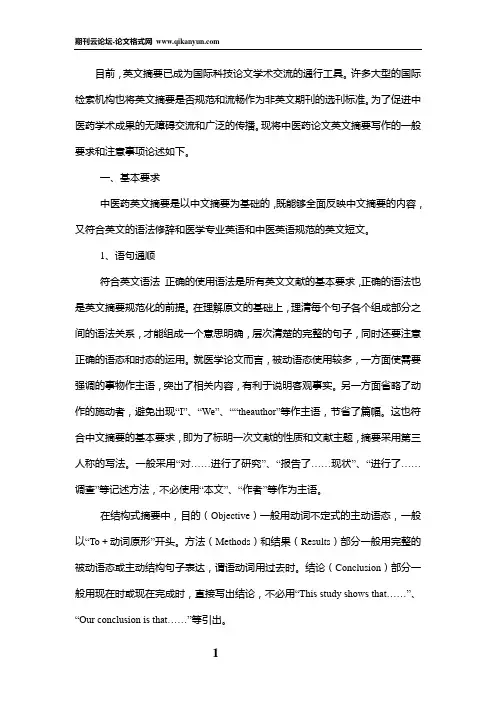
目前,英文摘要已成为国际科技论文学术交流的通行工具。
许多大型的国际检索机构也将英文摘要是否规范和流畅作为非英文期刊的选刊标准。
为了促进中医药学术成果的无障碍交流和广泛的传播。
现将中医药论文英文摘要写作的一般要求和注意事项论述如下。
一、基本要求中医药英文摘要是以中文摘要为基础的,既能够全面反映中文摘要的内容,又符合英文的语法修辞和医学专业英语和中医英语规范的英文短文。
1、语句通顺符合英文语法正确的使用语法是所有英文文献的基本要求,正确的语法也是英文摘要规范化的前提。
在理解原文的基础上,理清每个句子各个组成部分之间的语法关系,才能组成一个意思明确,层次清楚的完整的句子,同时还要注意正确的语态和时态的运用。
就医学论文而言,被动语态使用较多,一方面使需要强调的事物作主语,突出了相关内容,有利于说明客观事实。
另一方面省略了动作的施动者,避免出现“I”、“We”、““theauthor”等作主语,节省了篇幅。
这也符合中文摘要的基本要求,即为了标明一次文献的性质和文献主题,摘要采用第三人称的写法。
一般采用“对……进行了研究”、“报告了……现状”、“进行了……调查”等记述方法,不必使用“本文”、“作者”等作为主语。
在结构式摘要中,目的(Objective)一般用动词不定式的主动语态,一般以“To+动词原形”开头。
方法(Methods)和结果(Results)部分一般用完整的被动语态或主动结构句子表达,谓语动词用过去时。
结论(Conclusion)部分一般用现在时或现在完成时,直接写出结论,不必用“This study shows that……”、“Our conclusion is that……”等引出。
2、内容详略得当句型尽量简洁英文摘要的内容应该详略得当。
如果内容过于简略,就不能全面、客观的提示论文的主题。
不能因某些地方翻译的难度太大而放弃一些要点,造成实质内容的遗漏。
英文摘要是中文摘要的转译,不应该存在中文详细,英文过于简单或不译等现象。
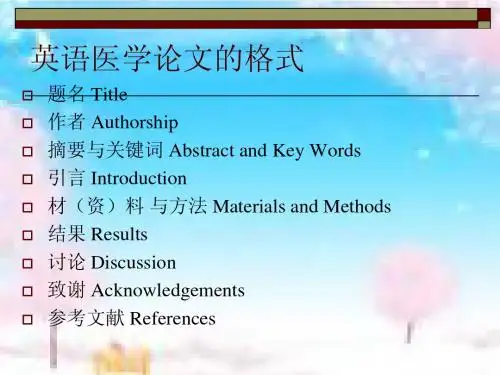
如何撰写医学论文英文摘要全Writing an extended abstract for a medical research paper, consisting of over 1200 words, requires a systematic approach to cover all essential aspects of the study. Here is a step-by-step guide on how to write an extended abstract for a medical research paper:1. Introduction (around 200 words):- Start by providing background information on the broader topic of your research.- Clearly state the research question or objective of your study.- Describe the significance and relevance of the research topic to the medical field.- Summarize the gaps in the existing literature that your research aims to address.- Briefly mention the research methodology employed in your study.2. Methods (around 300 words):- Describe the study design, including the type of study (observational, experimental, etc.).- Specify the population or sample size, including any inclusion or exclusion criteria used.- Outline the data collection methods employed in your study (interviews, surveys, laboratory tests, etc.).- Explain the statistical analyses used to analyze the data.3. Results (around 400 words):- Present the key findings of your research.- Use appropriate tables, graphs, or charts to illustrate the results.- Provide relevant statistical measures (e.g., mean, median, odds ratios, p-values, etc.).- Highlight any significant associations or correlations found.4. Discussion (around 400 words):- Interpret the results in the context of the research question and hypothesis.- Explain the implications and potential applications of your research.- Discuss the limitations of your study and suggest areasfor future research.- Emphasize the novelty and contribution of your study to the existing knowledge base.5. Conclusion (around 100 words):- Summarize the main findings and their clinical or scientific significance.- Reiterate the implications and contributions of your research.- Conclude by highlighting the strengths and limitations of your research.6. References:- Include a list of all the references cited throughout the abstract.- Follow an appropriate referencing style (APA, MLA, etc.).Remember to proofread your extended abstract for grammar, clarity, and consistency. Take into account that the specific word count distribution may vary depending on the requirements of the journal or conference to which you plan to submit your research paper.。
医学论文英文摘要写作注意事宜
医学论文英文摘要写作是研究者展示研究成果,吸引读者注意的重要环节。
本文主要介绍医学论文英文摘要的写作注意事项。
一、摘要长度
英文摘要长度一般在250~300单词之间,不超过400单词(不含关键词)。
摘要篇幅应控制在一页以内,内容要简洁扼要,不要过分详细,突出主要结果和结论。
二、注意语言
(1)确保语言准确无误,注意拼写、语法和标点符号的使用;
(2)不要使用缩略语和俚语,避免模糊不清的措辞;
(3)要确保用词规范,符合学术审美标准,避免使用颜色、味道、气味、触感等词汇;
(4)忌用夸张语句和修辞手法,例如“非常重要的发现”、“完全解决了”等等。
三、摘要内容
(1)目的:简洁明了地说明研究的目的;
(2)方法:简述研究方法、实验材料和数据分析方法;
(3)结果:介绍研究结果的主要发现和重要数据;
(4)结论:简述研究结论和未来研究的前景。
四、关键词
一般建议不超过5个关键词,并选用与论文内容相关的专业词汇。
在医学论文中,可以根据文章类别和内容特点来选择关键词。
以上就是医学论文英文摘要写作注意事项。
在撰写英文摘要时,需要注意语言准确规范、符合学术美感,突出主要研究结果和结论,那么写作的进展可以被更多人所关注。
医学考博作文摘要模板英文回答:Abstract.This study aims to investigate the impact of healthcare interventions on patient outcomes and healthcare costs. A systematic review of the literature was conducted to identify relevant studies. The findings suggest that healthcare interventions can significantly improve patient outcomes and reduce healthcare costs. However, the effectiveness of these interventions varies depending on the population, intervention type, and setting. Future research is needed to identify the most effective healthcare interventions for different patient populations and to develop strategies to scale up these interventions to improve population health outcomes and reduce healthcare costs.中文回答:摘要。
本研究旨在调查医疗保健干预措施对患者预后和医疗保健成本的影响。
进行了一项文献系统评价以识别相关研究成果。
研究结果表明,医疗保健干预措施可以显著改善患者预后,降低医疗保健成本。
然而,这些干预措施的有效性会因人群、干预类型和环境的不同而异。
医学论文英文摘要的写法
李若冰 李树桐
(大理医学院外语教研室 大理 671000)
2 结构式摘要
结构式摘要适用于研究性论文。
与传统的摘要写法相比,结构式摘要具有主题明显、语言简练等特点,使读者在捕捉信息时一目了然。
另外,作者按照这个结构写摘要,容易做到思路清楚,避免遗漏。
结构式摘要主要包括以下四个部分:(1)O b jective (目的);(2)
M ethods (方法);(3)R esu lts (结果);(4)Conclu si on s (结论)。
有了目的、
方法、结果、结论等主题词,我们就可以用更加简洁的语言来表达摘要中各部分的内容。
下面用具体例子说明结构式摘要各部分的写法。
211 O b jective (目的):简要说明本研究的目的及范围。
多用动词不定式短语表达,不需要再使用“T he p u rpo se ai m of th is study is ……(本研究的目的是……)”
等赘述。
如:O b jective :To m ake a p ri m ary clin ic study of X inm ailing In jecta on 12healthy vo l 2un teers 1
(目的:对12例健康自愿受试者进行“心脉龙注射液”的 期临床试验。
)O b jective :To m ake a retro spective analysis on the clin ical data of 55cases of SCD 1(目的:对55例心脏卒死(SCD )临床资料进行回顾分析。
)
其它常用的动词不定式短语有:to analyze ……(分析……),to describe …(阐述……),to assess …(测定……),to exam ine …(检查……),to iden tify …(鉴别……),to m easu re (测量……),to investigate …(调查……),to ob serve …(观察……),to study …(研究……),to detect …(识别……),to evaluate …(评估……),to deter m ine …(测定……),等等。
除了不定式短语外,还可以用分词短语、名词短语等来叙述目的。
如:
O b jective :D escrib ing the clin ical featu res of patien ts in w hom adrenal in sufficiency developed du ring m egestro l acetate therapy fo r advanced b reast cancer 1(分词短语)
(目的:阐述晚期乳腺癌患者在接受甲地孕酮治疗期间,出现肾上腺功能不全的临床特征。
)O b jective :R esearch on the distribu ti on and den sity of Α12adrenocep to rs in hum an
hepatic tissues (名词短语)
(目的:研究人肝组织Α12
肾上腺素受体分布的密度。
)O b jective :D eter m inati on of telom erase activity in H eL a cells (名词短语)
(目的:测定H eL a 细胞中端粒酶活性。
)
如果要表达两项以上目的,主题词用O b jectives ,复数形式。
如:
O b jectives :To deter m ine the associati on betw een w eigh t change in later years and the risk of fractu res in elderly w om en and to assess the effect of w eigh t lo ss in ten ti on on th is relati on sh i p 1
・
85・总第22期 李若冰等 医学论文英文摘要的写法 第7卷
(目的:确定老年体重变化与老年妇女发生骨折之间的关系,并评价体重减轻对此关
系的影响。
)212 M ethods (方法)说明研究使用的方法和材料,如何分组对照、
获取数据,使用何种统计方法等。
可以根据所表达的内容,用不完全句或完全句。
如:
M ethods :U sing the sleep analysis m ethod to analyze rabb its ’sleep ,u sing EL ISA to detect the levels of TN F in the serum and b rain s of m ice (动名词短语)(不完全句)
(方法:用睡眠时相分析方法分析家兔睡眠。
EL ISA 法测定小鼠血清及脑匀浆中
TN F 水平。
)M ethods :T h irteen patien ts w ith advanced b reast cancer w ere treated w ith o ral m egestro l acetate ,160m g d 1)(完全句)
(方法:13例晚期乳腺癌患者接受甲地孕酮口服治疗,每天160m g 。
)213 R esu lts (结果)列出研究结果、
主要数据及新发现等。
不用“T he resu lts show ed that …,W e found that …”
(结果表明……,我们发现……)等,只要在主题词R esu lts ,后面直接写出结果。
如:
R esu lts :D ram atic reducti on of the p eristalsic frequency of gastric body ,the con trac 2tive frequency of an trum and the sp eed of evacuati on (名词短语)
结果:营养不良患儿餐后胃体蠕动和胃窦收缩频率明显减少,液体胃排空速度明显减慢。
R esu lts :Fatigue and w eakness w ere ob served in all 13patien ts ;hypo ten si on ,in 8;ano rex ia ,nau sea ,vom iting ,and diarrhea ,in 3,M ean basal co rtiso l level at the ti m e of sym p tom s w as 4114nm o l L (range ,2716~11014nm o l L )A fter co rtico trop in sti m u la 2
ti on ,m ean co rtiso l level at 30m inu tes w as 23912nm o l
(range ,93.8~44710);at 60m in 2u tes ,228.2nm o l L (range ,8813~47415nm o l L )1
(结果:13例病人均感觉乏力,虚弱:8人出现低血压;3人出现厌食、恶心、呕吐、腹
泻。
以上症状出现时,皮质醇均值为4114nm o l L (范围2716~11014nm o l L )。
使用促皮
质素30分钟后,均值为23912nm o l L (范围9318~44710nm o l L ),60分钟后,均值为22812nm o l L (范围8813~47415nm o l L )。
R esu lts :D u ring an average of 1915m on th s after the fou rth exam inati on ,264w om en (4%)had at east 1non sp ine fracttu re ,including 83w om en w ho suffered frailty frac 2tu res 1
(结果:在第四次检查后平均1915个月的时间内,有264人(4%)至少发生过1次非
脊髓损坏性骨折,其中83人发生脆性骨折。
)214 Conclu si on s (结论)总结研究取得的经验,论证所得出的观点及其理论价值或应用价值,是否值得推荐或推广等。
可以省去“T he resu lts indicate that …,it is suggested that
…,”
(结果表明……,结果提示……)等,在主题词Conclu si on s (结论)后面直接写出结论。
如:
Conclu si on s :Strabo tom y to co rrect vertical strab is m u s shou ld be done first on pa 2tien ts having DVD w ith vertical strab is m u s ,and then decide w hether it is necessary to p erfo r m co rrecting operati on of DVD acco rding to the changes of DVD conditi on 1
(结论:对DVD 并垂直性斜视的患者,应首先矫正垂直性斜视,根据术后DVD 的变化情况,再决定是否行矫正术。
・95・总第22期 大理医学院学报 1998年第7卷第1期。